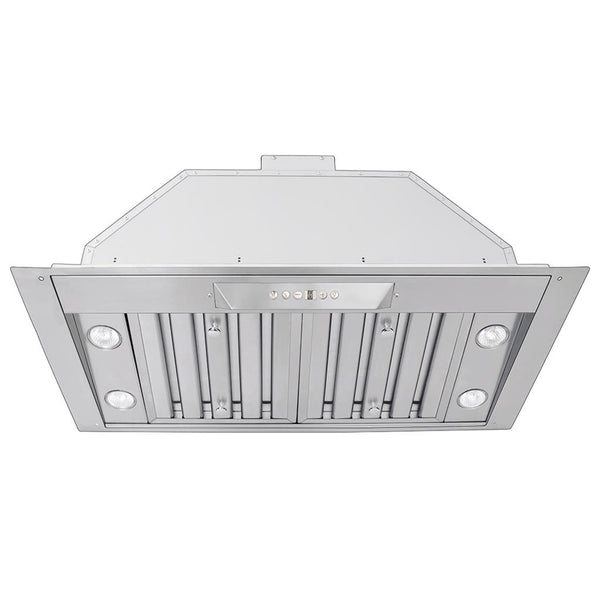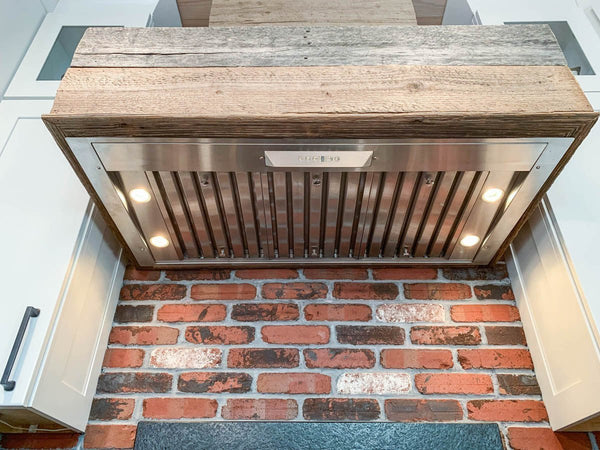Semi-rigid duct is more durable than flex duct, but rigid duct is the best for your range hood. Rigid duct is the most durable and generally made of higher-quality materials compared to flexible duct.
Can I use flexible duct for my range hood?
No. Avoid flexible duct for your range hood, regardless of the CFM. Flexible duct is a poor investment because it is:
- Not durable/sturdy
- Made of cheap materials
- Flimsy
- Difficult to maintain
Can I use 4-inch duct for a range hood?
Yes, but duct size depends on the CFM of your range hood. Four-inch duct is too small for most range hoods. It is only appropriate for hoods that are rated 400 CFM or under.
We recommend a minimum duct size of 6” for 600 CFM hoods, 8” for 900 CFM hoods, and 10” for 1200 CFM range hoods. Take a look at the graphic below for more information, or check out our full article on range hood duct sizing here.

What is the minimum duct size for a range hood?
The minimum duct size for a range hood is 4”. This duct size is appropriate for low-CFM hoods from big box stores. Most range hoods will require between 6” and 8” duct, while more powerful outdoor or professional range hoods may require 10” duct or larger.
What type of duct is best for venting a range hood?
Rigid duct is the best type of duct to vent your range hood. It requires a one-time installation and little to no maintenance as long as you clean your range hood filters. Most rigid ductwork is made from durable stainless steel, as opposed to rigid ductwork which is aluminum or flimsy plastic.
A range hood should last you 10+ years with minimal repairs or issues. Occasionally a light will burn out or a control panel may stop working, but ductwork, as long as it’s rigid, will remain intact. Otherwise, you will likely run into problems within a year or even a few months. Even if you seldomly cook, the safe, cost-effective bet is to go with rigid ductwork.
Is it OK to vent range hood into the attic?
No. You do not want grease, dirt, and chemicals from your kitchen air to build up in your attic. It is best to move it entirely out of your home. If you vent your hood into the attic, the buildup of dirt and chemicals can be dangerous to your health and is harmful to your home as well. It's imperative that you vent your hood to the exterior of your home, not into the attic, into walls, or between floors.
Is Master Flow insulated ductwork good for kitchen hood exhaust?
Yes, insulated ductwork works great for your kitchen hood. It reduces the noise of a blower inside the ductwork and allows less air to escape the duct. Rigid ductwork is the most long-lasting for your vent hood. The more powerful the hood, the larger the duct size you'll need.
Where do you vent a range hood?
You can vent a range hood through your wall horizontally or through your ceiling. Wall mount range hoods and under cabinet range hoods can be vented horizontally or vertically, while island hoods can only be vented vertically.
There is no ‘best way’ to vent your range hood, but you want to make sure that you have enough space behind your walls to run the ductwork before proceeding with the installation. Further, it is best practice to reduce the number of elbows in your ductwork. This maximizes the efficiency of airflow, creating a path of least resistance.
Your ductwork should have no more than three elbows. Further, make sure that you allow 18” of space between elbows to keep the amount of resistance manageable. Otherwise you’ll experience back-drafting, where air pulled into your hood falls back into your kitchen – this is never ideal!
What is the purpose of a transition duct for a range hood?
A transition duct for a range hood allows you to increase or reduce the size of your duct. For example, if you have an existing 4” duct, you can use a duct transition to increase its size to 6”. Duct transitions are important because a duct that’s too small reduces the efficiency of your hood.
Some transitions are duct reducers. For example, your duct would decrease from 10” to 8”. These aren’t necessary, though.
It’s more important to ensure you use an appropriately sized duct. Don’t use a duct smaller than our minimum requirements outlined above!
Here are a couple of examples of duct reducers compared. With the right sized duct, you’ll maintain laminar flow or the smooth flow of air through your duct. Learn more about laminar flow in this complete article.

Take a look at this chart once again for minimum duct sizes for your range hood.

We hope these answers to common questions about range hood ducting were helpful for you. Always hire a professional contractor or HVAC expert to install your ductwork. A well-done installation will be worth it in the long run, as you won’t have to worry about your range hood duct at all. It will allow the range hood as a whole to run more efficiently.
Remember to keep your filters in top shape too, which will drastically reduce the risk of any future issues with your blower or ductwork.
If you have any questions about ductwork, duct size, or anything else range hood related, call our customer support team at (877) 901-5530. We’ll see you next time.
Related Articles
How to Clean Your Range Hood Duct
Can I use semi-rigid duct for my range hood?
Can I use flexible duct for my range hood?
Not durable/sturdy
Made of cheap materials
Flimsy
Difficult to maintain













